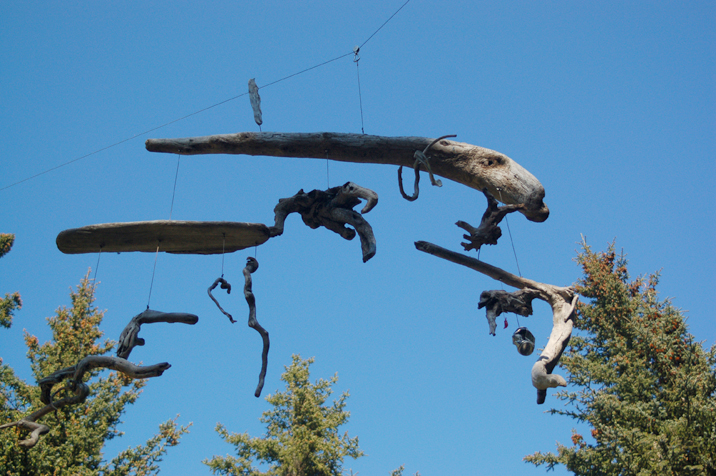Moose have trampled on its art. Vandals have stolen and trashed works. Some sculptures have been left in place, slowly returning back to the earth. Since 1994, Facing the Elements has merged art and nature on the Pratt Museum’s Forest Trail, testing creative ingenuity and inspiring imaginations.
The 19th annual show opened June 14, but when the museum begins construction of its new building in late 2014 or early 2015, this will be the last summer of Facing the Elements until completion of the new museum in 2016 or 2017. In the meantime, the show will take a hiatus.
“It’s so cyclical and regular, maybe people have lost a passion for it,” said Scott Bartlett, Pratt Museum curator of exhibits. “We want to give it a rest and time to breathe while we’re doing this work and come back with a big bang.”
Former education and exhibit director Carol Harding came up with the idea in the summer of 1995. Harding said artist Lynn Naden deserves much of the credit for the exhibit.
“She came up with the highly creative and timeless title, ‘Facing the Elements,’ which still holds true after 19 years,” Harding said.
Gale Parsons, who died in June 2008, later became director of exhibits and continued organizing Facing the Elements.
Over the years artists have used the space as display for sculptural art that could go in a museum. Others created installations that work with the land, light and space. Some have defied the space, like a giant billboard, and others have merged into it, like Mavis Muller and Parson’s “Fern Feather Labyrinth,” which has been in the same space since about 1998.
The exhibit was vandalized in 2000 and 2003, prompting a community outcry. In a Homer News article in 2000, Naden, a frequent contributor to the show, noted that some artists missed the point.
“It’s gotten way too precious,” she said. “It’s supposed to be ‘facing the elements.’ That’s not only the weather and the bears, but facing the hooligans.”
Part of the appeal can be how the elements change works over a season. Paint can fade. Grass can grow over installations. In one Naden work, a clay sculpture of a woman made in place against a tree, even gravity overcame art as the head sloughed off.
Last summer, under a grant from the Alaska Department of Natural Resources, Division of Parks and Outdoor Recreation Recreational Trails Program, the trail behind the museum was widened and built up with packed gravel. Part of the trail was rerouted to allow for construction of the new museum.
One constant has been the Muller-Parsons labyrinth, laid out in a small clearing across from the Forest Trail amphitheatre. The idea with a labyrinth is that visitors walk its decorated route to the center, meditating on the way, and then turn around and go back out.
“That’s sort of the magic the labyrinth brings, the opportunity to meander and think good thoughts,” Muller said.
Over the years, thousands of footprints have packed down the path of the labyrinth.
“It has now created what is clearly a permanent imprint on the land, like a tattoo,” Muller said.
This year’s sculptures include many works that fit the spirit of Facing the Elements. “Sticks and Stones” by Deb Lowney evokes Goldsworthy’s aesthetic, with a basket made of alder twigs. Michael McBride’s “Intersection,” a driftwood mobile placed above the amphitheater, has been rehung. With Trish Herrmann, Muller also has another piece, “Held,” a basket in which people are invited to place cones or other objects to release burdens from dealing with cancer or other medical challenges.
Another participatory work is Bartlett’s “Slit Drum,” a work based on the Tahitian percussion instrument and made from a dry tree that invites people to play the drum with an attached stick.
When Facing the Elements returns for its 20th season, Bartlett said the museum would like to celebrate its revival with perhaps a resident artist and some workshops, “make it a big to-do to reintroduce that exhibit with the new building.”
Muller said she’s looking forward to redoing the labyrinth.
“Sometimes taking a year off is good,” she said. “Sometimes we miss things when they’re not there. I think coming back is going to be a revival of that trail.”
Michael Armstrong can be reached at michael.armstrong@homernews.com.
Editor’s note: This story has been edited to note the contribution of former Pratt Museum education and exhibits director Carol Harding in coming up with the idea for Facing the Elements.


